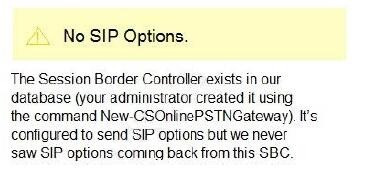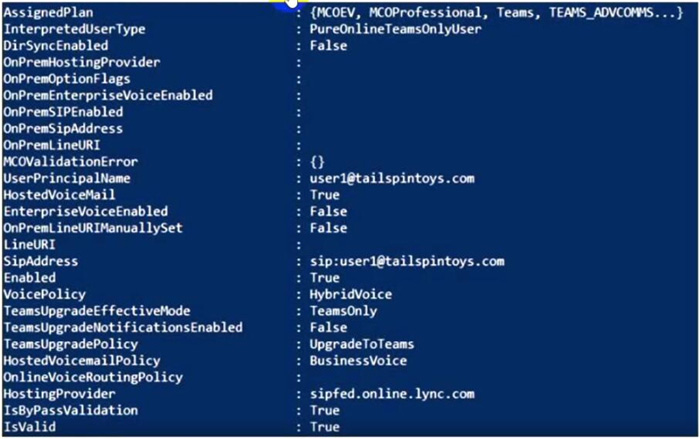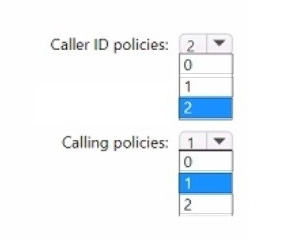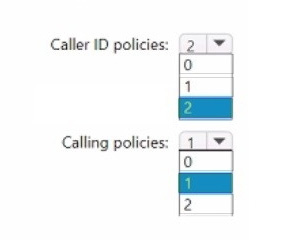MS-721 Online Practice Questions and Answers
Your company uses configuration profiles to manage Microsoft Teams-certified IP phones. The Standard configuration profile is applied to the IP phones.
The help desk receives reports that several user phones fail to lock automatically after the timeout period.
You need to verify whether the configuration profile is applied to the problematic phones.
Solution: From Devices in the Microsoft Teams admin center, you locate each affected phone and review the settings on the Details tab.
Does this meet the goal?
A. Yes
B. No
Your company has offices in 10 countries. The company has a tenant dial plan configured for each country.
The company recently opened an office in a new country.
You need to create a new tenant dial plan that meets the unique dialing requirements of the new country.
What should you do?
A. Run the New-CsOnlineVoiceRoutingPolicy cmdlet.
B. From the Microsoft Teams admin center, select Voice, select Dial plan, and then select Add.
C. From the Microsoft Teams admin center, select Locations, select Network topology, and then select Add.
D. Run the Sec-CsTenancDialPlan cmdlet.
You have a Microsoft Teams Phone deployment that uses Direct Routing.
You create a new Teams user named User1.
You need to enable User1 as an agent in a call queue.
What should you do first?
A. Assign a dial plan to User1.
B. Assign a phone number to User1.
C. Enable hosted voicemail for User1.
D. Enable Enterprise Voice for User1.
You create a network region Region1 in Microsoft Teams.
You are adding a network site to Region1. The site has a 1.5-Mb connection.
You need to ensure that all users at the site have a good voice experience.
What should you do?
A. Create and assign a Teams Network Roaming Policy that has IP video disabled.
B. Assign the Region1 users a meeting policy that has a media bit rate of 1,500 Kbps.
C. Run the Microsoft 365 network connectivity test tool.
D. Tag all traffic with a DSCP value of 46.
You need to create a new call queue to route calls to support agents. The support agents must be able to see their call queue history and the shared transcribed voicemail. The solution must minimize administrative effort.
Solution: You redirect calls for the call queue to a shared voicemail box.
Does this meet the goal?
A. Yes
B. No
You have a Microsoft Teams Phone deployment.
You are deploying Direct Routing.
All users have a SIP URI in the format of [email protected]. The Session Border Controller (SBC) is named sbc.voice.contoso.com.
When troubleshooting errors on the SBC, you receive the warning shown in the following exhibit.

What is a possible cause of the issue?
A. The firewall blocks outbound traffic on port 443 to Microsoft Teams.
B. The firewall blocks traffic to the signaling port on the SBC.
C. TLS 1.2 is enabled on the SBC.
D. Microsoft 365 Phone System licenses are not assigned to the users.
You are enabling users for Direct Routing.
You already assigned licenses to the users.
You need to complete the user setup.
Which two cmdlets should you run? Each correct answer presents part of the solution.
A. Set-CsOnlineVoiceUser
B. Grant-CsOnlineVoiceRoutinePolicy
C. Set-CsUser
D. Grant-CsVoicePolicy
E. Set-CsUSerPstnSettings
Your company has a Microsoft Teams Phone deployment that uses Direct Routing.
A user named User1 reports that she cannot make calls because the dial pad n missing in Teams.
You run the Get-CsOnlineUser cmdlet and receive the output shown in the exhibit (Click the Exhibit tab.)

Which three actions should you perform to ensure that the dial pad appears in the Teams client?
A. Assign a Microsoft Teams Phone Standard license to User1.
B. Run theGrant-CsOnlineVoiceRogtinfPolicy cmdlet
C. Run the set-csPhoneNumberAssignment cmdlet and specify the -PhonNumber parameter.
D. Run the set-CsUsre cmdlet and specify the -LineURI parameter.
E. Run the set-csuser cmdlet and set the -enterprisevoiceenabled parameter to $True.
You have a Microsoft Teams Phone deployment that contains common area phones located in a public lobby.
You need to enable Advanced calling features on all the common area phones.
What should you configure from the Microsoft Teams admin center?
A. a customization policy
B. a configuration profile
C. a calling policy
D. a policy package
You have a Microsoft Teams Phone deployment.
You need to ensure that when a user dials an emergency number, the security desk receives a notification to join the call.
Which type of policy should you configure?
A. messaging
B. emergency call routing
C. emergency calling
D. calling
Your company has a Microsoft Teams Phor>e deployment.
The company has a direct inward dial (DID) phone number range of +14035554300 to +14035554329.
Phone numbers +14035554310 to +14035554325 are assigned to Teams users, auto attendants, and call queues.
You need to ensure that when an unassigned number is dialed, the caller is forwarded to a call queue named Reception.
Which three actions should you perform? Each correct answer presents a part of the solution.
NOTE: Each correct selection is worth one point.
A. From the Microsoft Teams admin center, select Phone numbers, select Numbers, and then select Add.
B. Add the DID range of +14035554300 to +14035554329 to the phone number range.
C. Add the DID range of +14035554300 to +14035554309 to the phone number range.
D. Set Routing options to Person in organization and assign the Reception call queue.
E. From the Microsoft Teams admin center, select Phone numbers select Routing rules and then select Add a new rule
F. Set Routing options to Voice application and assign the Reception call queue.
You have a PBX phone system that contains 100 handsets. The handsets support SIP registration. You implement a new Microsoft Teams Phone deployment that has SIP Gateway configured. You need to register the handsets with Teams. What should you do?
A. From the Microsoft Teams admin center, create a configuration profile for each device. Configure the handsets to use LLDP.
B. From the voice calling policy, set SIP devices can be used for calls to On. Configure the handsets to use LLDP.
C. From the Microsoft Teams admin center, create a configuration profile for each device. Add the Teams SIP device details to the handsets.
D. From the voice calling policy, set SIP devices can be used for calls to On. Configure the provisioning URL on the handsets.
Your company uses Microsoft Teams live events for online employee training sessions.
During the last live event, there were 100 attendees in a remote office. The attendees reported connectivity issues.
You discover that the internet connection at the remote office was saturated.
You need to minimize the impact of live events on the internet links of the remote office.
What should you do?
A. Configure a network roaming policy.
B. From Meeting policies, modify Media bit rate (KBs).
C. Configure Quality of Service (QoS).
D. Configure a video distribution provider eCDN.
You have a Microsoft Teams Phone deployment.
You need to ensure that users can enter their emergency address into the Teams client.
Which setting should you configure?
A. External location lookup mode
B. Trusted IPs
C. Optimized device dialing
D. Location based routing
HOTSPOT
Your company has a Microsoft Teams Phone deployment and the following departments:
HR
Marketing
You need to configure Teams to meet the following requirements:
Only users in the HR department must have spam filtering enabled.
All outbound PSTN calls must replace the caller ID with the company's auto attendant number.
Only users in the marketing department must have Inbound calls can be routed to call groups disabled.
What is the minimum number of caller ID policies and calling policies you should configure? To answer, select the appropriate options in the answer area.
NOTE: Each correct selection is worth one point.
Hot Area:


